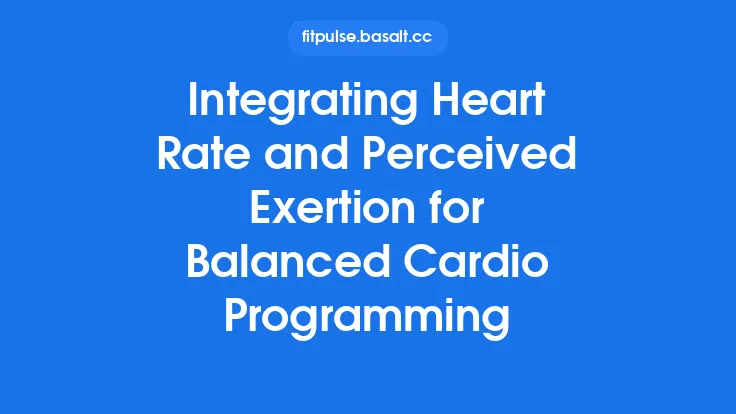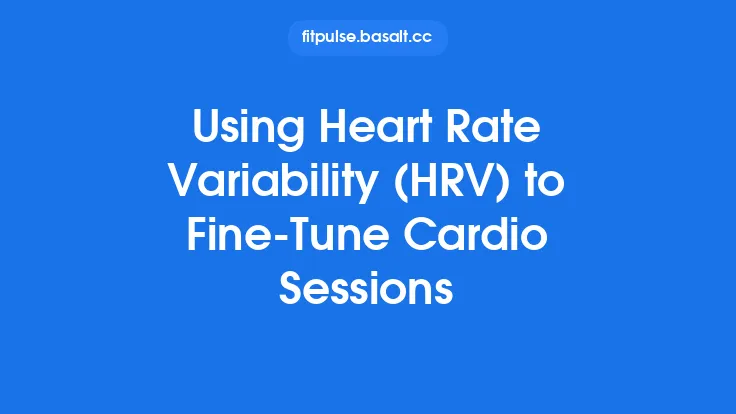Heart rate variability (HRV) has emerged as a powerful, non‑invasive indicator of autonomic nervous system balance and overall physiological readiness. When incorporated thoughtfully into program evaluation, HRV offers a window into how an individual’s body is responding to training loads, recovery strategies, and lifestyle stressors. Unlike traditional performance metrics that capture outcomes after the fact, HRV provides a real‑time, day‑to‑day snapshot of internal load, allowing coaches and practitioners to make evidence‑based adjustments before fatigue or overtraining manifests.
Understanding the Physiology Behind HRV
HRV quantifies the variation in time intervals between successive heartbeats, known as R‑R intervals. These fluctuations are driven by the dynamic interplay between the sympathetic (fight‑or‑flight) and parasympathetic (rest‑and‑digest) branches of the autonomic nervous system (ANS). A higher HRV generally reflects dominant parasympathetic activity and a well‑recovered state, whereas a lower HRV indicates sympathetic dominance, often associated with stress, fatigue, or insufficient recovery.
Key physiological concepts to grasp:
- Time‑Domain Measures – Simple calculations such as the standard deviation of normal-to-normal intervals (SDNN) and the root mean square of successive differences (RMSSD). RMSSD is especially popular for short‑term recordings because it correlates strongly with vagal tone.
- Frequency‑Domain Measures – Spectral analysis separates HRV into components (e.g., low‑frequency [LF] and high‑frequency [HF] bands). The HF band is linked to parasympathetic activity, while the LF band reflects a mix of sympathetic and parasympathetic influences.
- Non‑Linear Metrics – Techniques like Poincaré plots, sample entropy, and detrended fluctuation analysis capture the complex, chaotic nature of heart rhythm dynamics, offering deeper insight into autonomic regulation.
Selecting the Right HRV Toolset
A multitude of consumer‑grade wearables, chest‑strap monitors, and dedicated ECG devices now provide HRV data. For program evaluation, the choice of tool should balance accuracy, ease of use, and data accessibility.
- Chest‑Strap ECG Sensors – Provide gold‑standard R‑R interval accuracy, ideal for athletes and high‑performance settings.
- Photoplethysmography (PPG) Wrist Devices – Convenient for daily monitoring but may be susceptible to motion artefacts; validation against ECG is essential.
- Dedicated HRV Apps – Many platforms (e.g., Elite HRV, HRV4Training) incorporate guided measurement protocols, automatic artefact correction, and trend visualizations.
When selecting a device, verify that it offers raw R‑R interval export (e.g., .csv, .txt) to enable custom analysis and integration with broader program evaluation dashboards.
Establishing a Consistent Measurement Protocol
Reliability hinges on consistency. The following protocol is widely accepted for day‑to‑day HRV tracking:
- Timing – Record first thing in the morning, preferably within 30 minutes of waking, before caffeine, food, or physical activity.
- Position – Supine or seated with a relaxed posture; avoid talking or moving during the recording.
- Duration – A minimum of 5 minutes for time‑domain metrics; 10 minutes yields more stable frequency‑domain data.
- Environment – Quiet, temperature‑controlled space to minimize external stressors.
- Breathing – Natural breathing is acceptable, but a paced breathing protocol (e.g., 6 breaths per minute) can enhance parasympathetic signal detection for research‑grade assessments.
Documenting contextual variables (sleep quality, perceived stress, nutrition, recent training) alongside HRV values enriches interpretation and supports nuanced program adjustments.
Interpreting HRV Trends for Program Evaluation
Rather than focusing on isolated daily values, evaluators should examine trends over time. Several analytical approaches are useful:
- Rolling Averages – A 7‑day or 14‑day moving average smooths day‑to‑day variability, revealing underlying shifts in autonomic balance.
- Z‑Score Normalization – Convert each day’s HRV to a Z‑score relative to an individual’s baseline period (e.g., first 2–4 weeks). This highlights deviations that are statistically meaningful for that person.
- Delta‑HRV – Calculate the day‑to‑day change (ΔHRV). A sustained negative delta over several days may signal accumulating fatigue.
- Composite Load Index – Combine HRV trend data with external load metrics (e.g., session RPE, volume) to generate a “training stress balance” score. A negative balance (high load, low HRV) suggests the need for recovery interventions.
Practical Decision‑Making Scenarios
| HRV Trend | External Load | Recommended Action |
|---|---|---|
| Stable or ↑ HRV | Moderate load | Continue current programming |
| Slight ↓ HRV (1–2 SD) | High load | Introduce active recovery or reduce volume |
| Persistent ↓ HRV (>3 SD) | High load | Implement deload week, prioritize sleep/nutrition |
| ↑ HRV after a low‑load week | Low load | Consider progressive overload in next cycle |
These guidelines are not prescriptive rules but decision‑support cues that should be contextualized with the athlete’s goals, sport demands, and other health markers.
Integrating HRV into a Holistic Program Evaluation Framework
HRV should complement, not replace, other evaluation components. A robust framework might include:
- Objective Performance Data – Strength, power, or skill metrics collected at defined intervals.
- Subjective Wellness Scores – Mood, soreness, and perceived readiness questionnaires.
- Recovery Interventions Log – Documentation of sleep, nutrition, hydration, and modalities (e.g., massage, compression).
By aligning HRV trends with these data streams, evaluators can triangulate the cause‑effect relationship between training stimuli and physiological response. For instance, a dip in HRV coinciding with poor sleep quality and elevated perceived fatigue strengthens the case for a recovery‑focused intervention.
Advanced Analytical Techniques
For programs that demand deeper insight, consider the following methods:
- Time‑Series Modeling – Autoregressive Integrated Moving Average (ARIMA) models can forecast HRV trajectories and flag outliers.
- Machine Learning Classification – Supervised algorithms (e.g., random forests) trained on HRV, load, and wellness data can predict “high‑risk” days for overreaching.
- Network Physiology – An emerging field that examines HRV alongside other biosignals (e.g., cortisol, skin temperature) to map systemic stress networks.
While these techniques require statistical expertise, they can elevate program evaluation from descriptive to predictive, enabling proactive periodization adjustments.
Addressing Common Pitfalls
- Over‑Interpretation of Single Values – One low HRV reading does not automatically indicate overtraining; consider the broader trend.
- Inconsistent Measurement Conditions – Variations in time of day, posture, or device can introduce noise; standardization is key.
- Neglecting Individual Baselines – HRV is highly individualized; population norms are less informative than personal historical data.
- Ignoring External Stressors – Psychological stress, travel, or illness can depress HRV independent of training load; capture these factors in logs.
By anticipating these challenges, evaluators can maintain data integrity and derive actionable insights.
Implementing HRV‑Driven Adjustments: A Step‑by‑Step Workflow
- Baseline Establishment – Collect daily HRV for 2–4 weeks under stable training conditions.
- Define Thresholds – Set individualized Z‑score or SD thresholds that trigger review (e.g., −1.5 SD for 3 consecutive days).
- Daily Review – Automated dashboards flag days that breach thresholds.
- Contextual Check – Cross‑reference flagged days with sleep, nutrition, and training logs.
- Decision Point – Choose from a menu of interventions (load reduction, recovery modality, sleep hygiene focus).
- Document Outcome – Record the intervention and subsequent HRV response.
- Iterate – Refine thresholds and intervention protocols based on observed efficacy.
This systematic loop ensures that HRV data translate into concrete program modifications rather than remaining an abstract metric.
Case Illustration (Hypothetical)
Athlete Profile: 28‑year‑old male endurance cyclist preparing for a 3‑week stage race.
- Baseline HRV (RMSSD): 55 ± 8 ms over 3 weeks.
- Training Load: Progressive increase from 8 to 12 hours/week, with two high‑intensity interval sessions per week.
Week 5 Observation: RMSSD dropped to 38 ms (≈−2.1 SD) for three consecutive mornings. Sleep logs indicated 5–6 h/night, and the athlete reported elevated perceived stress due to work travel.
Intervention: Coach reduced high‑intensity sessions by 30 % and added a dedicated recovery day with low‑intensity spin and mobility work. Sleep hygiene recommendations were reinforced.
Outcome: RMSSD rebounded to 48 ms within 4 days, and the athlete reported improved readiness. Training load was then gradually increased, monitoring HRV to ensure stability.
This example demonstrates how HRV can serve as an early warning system, prompting timely adjustments that preserve performance potential.
Future Directions and Emerging Research
- Wearable Integration with Cloud‑Based Analytics – Real‑time HRV streaming to AI platforms promises automated load‑recovery balancing.
- HRV‑Guided Periodization Models – Studies are exploring algorithms that dynamically adjust macro‑cycles based on autonomic feedback.
- Population‑Specific Norms – Research is refining HRV reference ranges for different sports, age groups, and gender, enhancing interpretive precision.
- Multimodal Biomarker Fusion – Combining HRV with blood biomarkers (e.g., CK, IL‑6) may improve detection of subclinical fatigue.
Staying abreast of these developments ensures that program evaluation remains at the cutting edge of sports science.
Key Takeaways
- HRV offers a sensitive, day‑to‑day gauge of autonomic balance, reflecting the body’s readiness to train or recover.
- Consistent measurement protocols and individualized baselines are essential for meaningful interpretation.
- Trend analysis, rather than isolated values, drives actionable insights for program evaluation.
- Integrating HRV with other objective and subjective data creates a holistic view of training impact.
- Advanced analytics can elevate HRV from a descriptive metric to a predictive tool, supporting proactive program design.
By embedding HRV monitoring into the evaluation workflow, coaches, clinicians, and athletes gain a scientifically grounded, evergreen resource for optimizing training effectiveness while safeguarding health and longevity.




